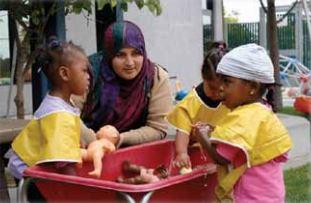66 13.2: What Programs Can Do to Support Children with Religious Differences
Early childhood education programs are often the first context in which children are confronted with different religions and religious attitudes than those experienced in their family environment, and it is very important that they learn to treat each other with respect and to be sensitive to differences. Taking children’s opinions and interests into account and exploring how early childhood educational institutions deal with religious differences contributes to both childhood research and raising awareness of aspects of dealing with religious differences in educational institutions, which has not often been researched.
Young children notice religious differences, even when they don’t quite understand it or may not have the language to fully explain it. Even though it is noticeable, religious differences are often overlooked in early childhood education. “Many teachers are uncomfortable talking about religion in their classrooms, yet many schools continue to celebrate the traditional Christian holidays, such as Easter and Christmas, which further marginalizes non-Christian students.” [184]
The Importance of Communication
Communication plays a key role in dealing with religious difference. Religious difference increases the need for communication about religion and religions. People get to know each other in two-way conversations. “Otherness is not threatening, but awakens the desire for communication. It is precisely because one or the other is different that we need communication.”
Early childhood education is a place for discussions between teachers, with administrators, and with children and families. If the staff and/or families in an early childhood program have different religious affiliations, communication about their different religious traditions makes sense in the kindergarten.
Questions early childhood education programs should ask themselves, include:
Values
- What is the value base of the program?
- Who defines and promotes these values?
- How do these values encourage and promote dialogue and respect? • How do the values reflect the religious difference of the families served by the program?
- Are these values publicized and agreed upon with the families and community the program serves?
Policy
- How is religious difference taken into account and addressed in the admission of children to kindergarten?
- How far do policies promote values of religious difference and respect?
Program Recognition
- How does the program take religious differences into account?
- To what extent does the calendar reflect religious difference?
- To what extent do holidays reflect the diversity of religious holy days?
- To what extent is the religious difference in the range of meals offered in kindergarten considered?
- How is the wearing of certain clothing or religious symbols dealt with?
- How are conflicts and challenges arising from religious differences addressed?
Curriculum
- How does the curriculum address religious differences and how are they received by children?
- How far is the program’s tradition based on the dominant religion of the program and/or larger community?
- When and in which areas is religious difference discussed?
Professional Development of Teachers
- How are teachers prepared to address religious difference?
- What opportunities are there for educators to educate themselves in relation to religious difference, and how are these opportunities taken advantage of?
Communication about religious difference
- How do programs connect with families to learn their desires for dealing with religious differences?
- How and when do team meetings take place in the program in which questions of religious difference are discussed?
- When do children address religious difference and how are children’s curiosities about religion addressed?
Communication about religious difference can bring challenges. But when programs create trusting, reciprocal relationships with families, dealing with conflicts, including dealing with religious conflicts, offers the opportunities for programs to become more culturally responsive. [185]
Recognition of Minority Religions
In education, including early childhood education, there is a tendency to focus exclusively on the major religion, but not on the minor religions and religious differences. Research has found that children of the minor religions often do not feel comfortable expressing themselves about their religion or their religious expressions and that their religion is given little attention by early childhood education programs in general or in the behavior of the teachers. Inclusion and integration of all religions, both major and minor. Children should be not be expected to assimilate to the major religion. Religious students should have the opportunity to address their religious perspective and not hide it. When children of different world religions live together in the group, the children have a right to be heard and told about their respective traditions. [186]
Remembering Individual Differences in Religiousness
Children and adults belonging to a religion are also different in their religiousness, which can be seen in different forms of expression. It is important for early childhood educators to remember that how families observe and express their religion will vary, even within the same religion. [187]
Creating a Safe Place for Exploration
Even if complete equity cannot be achieved in early childhood education, it is important to strive for it and to develop a safe space in which children are recognized in their individuality and their difference and in which they can address topics that concern them. While most early childhood settings appear to be calm and friendly places on the surface, there may be a great deal of underlying inequity in practice, as both adults and children inevitably bring with them their own perceptions and prejudices to the setting and in their interactions with one another. [188]
If the children’s religion and the resulting religious difference have no place in the kindergarten – if it is important to them – a part of them has no place. [189]
Child-Centered Exploration of Religion
The naturalness and curiosity with which children encounter religious difference is a good foundation or learning processes about religious difference. The children’s conversations or questions that suddenly arise during the program day can, provided that they are perceived and sensitively taken up by the educators, be opportunities for learning, in which an examination of religious difference can take place. [190] “For young children, sharing their stories can be a vehicle to open conversations about religion and diversity.” [191]
Religious Differences Surrounding Food
Early childhood education programs should provide food that can be enjoyed by all children. Mealtimes offer a chance to make religious differences visible in the different eating habits of the children. It is critical that cultural (and religious) differences in food and meals be understood and respected by the program. How religious eating habits are dealt with in meals can therefore be an important indication of how religious differences are dealt with by the program in general. [192]
Clothing, Hairstyle, and Head Coverings
Some families may have religious practices that prescribe specific clothing, hairstyle, or head coverings. Early childhood education programs must learn about these practices from the families and help children follow these practices while the child is in the care of the program. [193]

Celebrations
“Holidays and celebrations are important topics in schools because they offer interesting and relevant opportunities for students to learn about cultures different than their own and to develop awareness of how religion influences cultures.” [195] Early childhood education programs should be careful that the celebrations they observe are authentic and reflect the values and beliefs of the families, they serve. The unique celebration of a festival of another religion without other consideration of religious difference in the program seems to miss the desired intentions despite the positive intentions. When festivals are celebrated, the question arises how this is done so that the celebration is not perceived as an “exotic activity” but is based on the recognition of religious difference in the program. [196]
Using Children’s Literature
Multicultural children‘s literature can be used to help children become more aware of the many religions and religious traditions. “Reading and discussing multicultural literature fosters opportunities for students to not only learn about world religions, but to explore commonalities and differences amongst people from a variety of places and religious practices (Dever, Whitaker, & Byrnes, 2001).” [197]
Factual Information
Children need explanations from adults in order to understand religious differences they notice. Children are often not given an explanation on the religious background of some children who observe different religious traditions. If the children do not know the reason for the difference, they may unintentionally find an explanation that is hurtful or irritating for the children concerned.
Due to the importance of teachers in early childhood institutions and the teacher’s diverse tasks in dealing with religious differences, teachers require interreligious competence. [198]
Professional Development
Early childhood educators often experience insecurity and fear of dealing with conflict or challenging situations, including those surrounding religious differences. Training of awareness of religious difference and the expansion of knowledge about different religions can take place to help build knowledge. Through support and professional development opportunities, the fears and concerns of the teachers and administrators can be addressed. This can lead to increased comfort surrounding addressing religious differences.
Staff meetings in which opportunities and challenges are discussed together make it clear that religious difference is not the concern of a single person in the program, but rather a common concern. Further training dedicated to the desires of the staff can be context-sensitive to the specific program and its situation.
One area that deserves further attention and training is that examination of one’s own prejudices, as is implemented in an anti-bias approach. [199]
Dealing with One’s Own Religiousness
In addition to knowledge, it is important for educators to examine their own values and attitudes in order to develop a sensitivity to different religions and world views. Dealing with one’s own religion and religiousness is important to
- avoid confusing their own feelings with statements or actions of children.
- be able to receive children’s opinions as impartially as possible.
- recognize the significance that religion could have for children.
- be able to recognize that in addition to the challenges that religious difference can bring, it also brings opportunities. [200]
|
|
Think About It… How might it feel if you are caring for a child with different religious beliefs than your own (maybe even contradictory)? What would you need to do to ensure the child and family’s beliefs are respected and honored in your classroom? |


